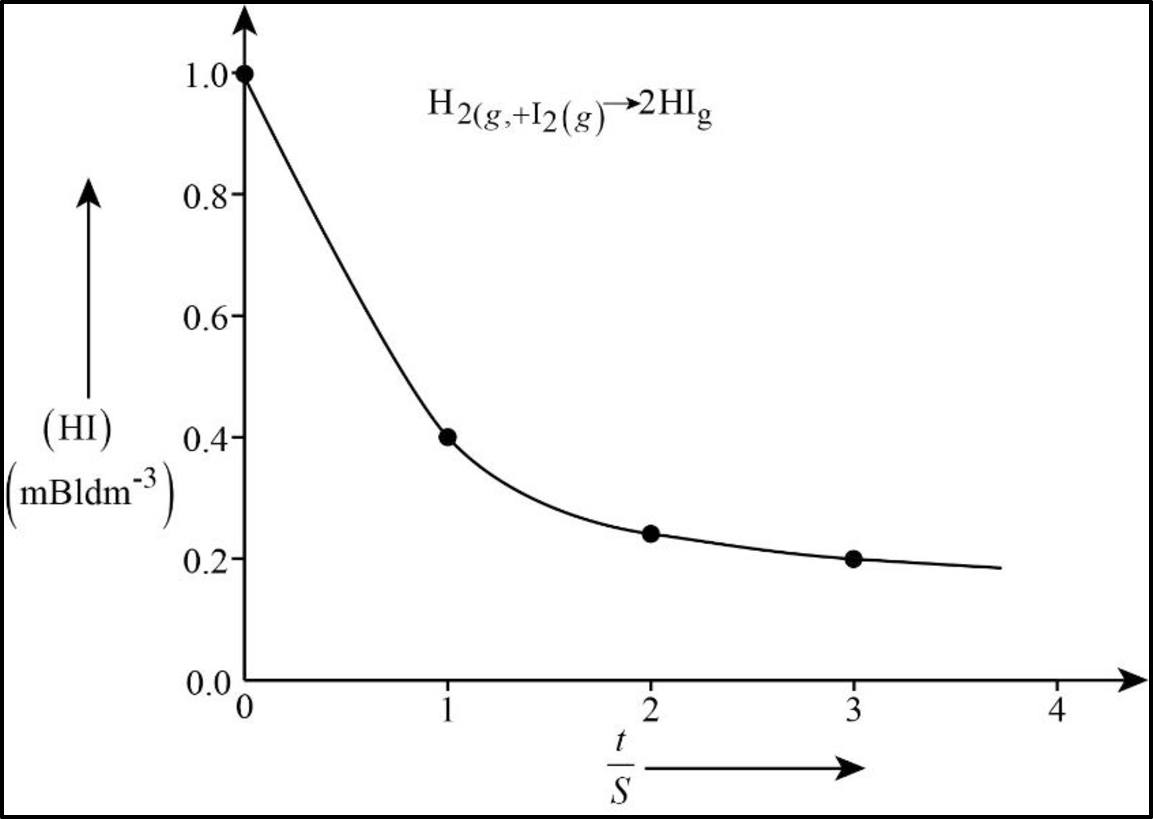
(a)
Interpretation:
The following data were collected for the given reaction at
Concept Introduction:
Rate of a reaction: It represents the speed at which a
Rate of reaction depends on time, temperature, pressure, concentration, and
Rate of the reaction is the change in the concentration of reactant or a product with time. It can be varied in accordance with temperature, pressure, concentration, presence of catalyst, surface area.
General rate reaction is,
The negative sign indicates the reduction of concentration of reactant.
Integrated rate law for first order reaction:
Consider A as substance, that gives the product based on the equation,
Where a= stoichiometric co-efficient of reactant A.
Consider the reaction has first-order rate law,
The integrated rate law equation can be given as,
The above expression is called integrated rate law for first order reaction.
(a)
Explanation of Solution
Given reaction is,
Record the given data’s
Let us consider the first order reaction
Rate constant is,
Given values are plugging above equation,
Hence, the all rate constant are nearly same, so this reaction confirmed to be first order reaction.
(b)
Interpretation:
Plot the given data in an appropriate fashion, the rate constant has to be determined.
Concept Introduction:
Rate of a reaction: It represents the speed at which a chemical reaction runs. How much concentration of substrates (reactants) consumed and how much concentration of targets (products) formed in a unit of time is said to be rate of reaction.
Rate of reaction depends on time, temperature, pressure, concentration, and
Rate of the reaction is the change in the concentration of reactant or a product with time. It can be varied in accordance with temperature, pressure, concentration, presence of catalyst, surface area.
General rate reaction is,
The negative sign indicates the reduction of concentration of reactant.
(b)
Explanation of Solution
Given reaction is,
Record the given data’s
In order to determine the rate law, we need to determine the order of the reaction with respect to
For a zeroth order reaction
In the present case a plot
The rate law is thus

Figure 1
Want to see more full solutions like this?
Chapter 6 Solutions
Us Solutions Manual To Accompany Elements Of Physical Chemistry 7e
- Which of these correspond to the molecule: 2,5-dimethylheptanearrow_forwardGiven the following data, determine the order of the reaction with respect to H2. H2(g) + 21Cl(g) → I2(g) + 2HCl(g) Experiment [H2] (torr) [ICI] (torr) Rate (M/s) 1 250 325 0.266 2 250 81 0.0665 3 50 325 0.266arrow_forwardWhich one of the following molecules is chiral? H- NH₂ H3C དང་།་ OH H HO H₂N HO- -H CHO -OH H HO- OH H- -H CH₂OH OHarrow_forward
- The structure of an unsaturated phospholipid is shown below. Which region of the molecule is most hydrophilic ? H₂N-CH₂ H₂C IV CH3 CH3 hydro-water philic-likes = Hydrophilic likes water ○ IV All regions are equally hydrophilic. IIIarrow_forwardWhich of the following compounds would you most appropriately call hydrophobic? ○ CH4 H2CO CO HCI ○ NaClarrow_forwardWhich of the following triglycerides would you most expect to be a liquid at room temperature? saturated fat trans monounsaturated fat trans polyunsaturated fat cis monounsaturated fat ○ cis polyunsaturated fatarrow_forward
- Which best describes the intermolecular forces present in NH3? dispersion forces only hydrogen bonding and dispersion forces dipole-dipole, hydrogen bonding, and dispersion forces dipole-dipole forces only ion-dipole and dispersion forcesarrow_forwardList three structural features and corresponding absorption ranges that can be used to identify cyclohexene by IR spectroarrow_forwardThe following chemical structure represents a molecule of what molecular formula? N.arrow_forward
- Predict the product(s) of the following reactions. If no reaction, write "NR". a) b) HNO3 H2SO4 SO3 H2SO4 c) Bra FeBr3 Br2, FeBrз OCH3 d) تمنی e) HO f) SO3 H2SO4 CH3Cl NO2 AICI3arrow_forwardHow could you get from the starting material to product? A. OH B. OH Όarrow_forwardGivent that the molecule below is named 2-methylbutanal (aldehyde) Choose the correct IUPAC nomenclature of the molecule: 4-methylpentanal 2-methylpentanal 4-methylbutanal 4-methylbutanalarrow_forward
 ChemistryChemistryISBN:9781305957404Author:Steven S. Zumdahl, Susan A. Zumdahl, Donald J. DeCostePublisher:Cengage Learning
ChemistryChemistryISBN:9781305957404Author:Steven S. Zumdahl, Susan A. Zumdahl, Donald J. DeCostePublisher:Cengage Learning ChemistryChemistryISBN:9781259911156Author:Raymond Chang Dr., Jason Overby ProfessorPublisher:McGraw-Hill Education
ChemistryChemistryISBN:9781259911156Author:Raymond Chang Dr., Jason Overby ProfessorPublisher:McGraw-Hill Education Principles of Instrumental AnalysisChemistryISBN:9781305577213Author:Douglas A. Skoog, F. James Holler, Stanley R. CrouchPublisher:Cengage Learning
Principles of Instrumental AnalysisChemistryISBN:9781305577213Author:Douglas A. Skoog, F. James Holler, Stanley R. CrouchPublisher:Cengage Learning Organic ChemistryChemistryISBN:9780078021558Author:Janice Gorzynski Smith Dr.Publisher:McGraw-Hill Education
Organic ChemistryChemistryISBN:9780078021558Author:Janice Gorzynski Smith Dr.Publisher:McGraw-Hill Education Chemistry: Principles and ReactionsChemistryISBN:9781305079373Author:William L. Masterton, Cecile N. HurleyPublisher:Cengage Learning
Chemistry: Principles and ReactionsChemistryISBN:9781305079373Author:William L. Masterton, Cecile N. HurleyPublisher:Cengage Learning Elementary Principles of Chemical Processes, Bind...ChemistryISBN:9781118431221Author:Richard M. Felder, Ronald W. Rousseau, Lisa G. BullardPublisher:WILEY
Elementary Principles of Chemical Processes, Bind...ChemistryISBN:9781118431221Author:Richard M. Felder, Ronald W. Rousseau, Lisa G. BullardPublisher:WILEY





